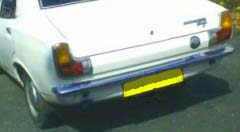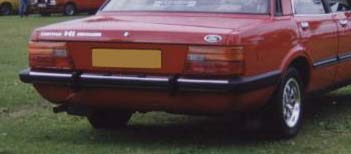GLITCH ART
ASPECT RATIO OF CAR LIGHTS
PROLOG
Why write an article on, of all things, car rear lights,
for a website about glitch art? It's a tenuous link, but a lot
of my glitch work involves data visualization, which is
essentially converting numbers into colours. The "glitch" aspect
is what determines the source of the numbers, such as a region
of uninitialized computer memory. But it's important to consider
the other side of the equation too; the representation of those
numbers as regions of colour on your computer monitor. I don't have
to map a number to a single pixel. In fact, I map numbers to
solid rectangles of colour. The size and aspect ratio of the rectangle
used are determined by my aesthetic sensibilities. Sometimes I want
big blocky, obviously pixellated images. Sometimes I want the rectangles
to be long and thin. And this is where rectangles in the world around us
come into play; the rectangles I have grown up liking as a child are the
ones I tend to use in my present-day images.
1978
In 1978 I was 7 years old. The previous year was the UK Queen's
Silver Jubilee. Summers were hot and skateboarding was in. My
Dad's company car was a Hillman Avenger with horrible rear lights
that curved upwards in an L shape.
 Hillman Avenger - WRONG!
His next car was a Ford Escort, which had better rear lights -
at least they were nearly rectangular. However, they were too
squareish for my liking.
Hillman Avenger - WRONG!
His next car was a Ford Escort, which had better rear lights -
at least they were nearly rectangular. However, they were too
squareish for my liking.
 Ford Cortina - WRONG!
I really wanted my Dad to get a sleek Ford Granada
with those stylish long, sleek rear lights! Kudos is definitely
due to whoever designed those lights!
The aspect ratio is spot-on and complements the overall size of the
car perfectly. From direct measurement of this photo, the aspect ratio
is approx 3.84, excluding the part that wraps around the side of the car.
Ford Cortina - WRONG!
I really wanted my Dad to get a sleek Ford Granada
with those stylish long, sleek rear lights! Kudos is definitely
due to whoever designed those lights!
The aspect ratio is spot-on and complements the overall size of the
car perfectly. From direct measurement of this photo, the aspect ratio
is approx 3.84, excluding the part that wraps around the side of the car.
 Ford Granada - RIGHT!
Ford Granada - RIGHT!
GLITCH ART
 Hillman Avenger - WRONG!
His next car was a Ford Escort, which had better rear lights -
at least they were nearly rectangular. However, they were too
squareish for my liking.
Hillman Avenger - WRONG!
His next car was a Ford Escort, which had better rear lights -
at least they were nearly rectangular. However, they were too
squareish for my liking.
 Ford Cortina - WRONG!
I really wanted my Dad to get a sleek Ford Granada
with those stylish long, sleek rear lights! Kudos is definitely
due to whoever designed those lights!
The aspect ratio is spot-on and complements the overall size of the
car perfectly. From direct measurement of this photo, the aspect ratio
is approx 3.84, excluding the part that wraps around the side of the car.
Ford Cortina - WRONG!
I really wanted my Dad to get a sleek Ford Granada
with those stylish long, sleek rear lights! Kudos is definitely
due to whoever designed those lights!
The aspect ratio is spot-on and complements the overall size of the
car perfectly. From direct measurement of this photo, the aspect ratio
is approx 3.84, excluding the part that wraps around the side of the car.
 Ford Granada - RIGHT!
Ford Granada - RIGHT!